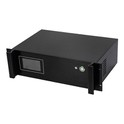As a supplier of the Resoring - 30 ultrasonic ring, one of the most frequently asked questions I encounter is whether this innovative device produces any noise during operation. In this blog post, I will delve into the science behind the Resoring - 30 ultrasonic ring and provide a comprehensive answer to this query.
Understanding Ultrasonic Technology
Before we discuss the noise aspect, it's essential to understand how ultrasonic technology works. Ultrasonic cleaning relies on high - frequency sound waves, typically above the human audible range (20,000 Hz). These sound waves create microscopic bubbles in a cleaning solution through a process called cavitation. When these bubbles collapse, they generate a powerful cleaning action that can remove dirt, grime, and contaminants from various objects.
The Resoring - 30 ultrasonic ring is designed to utilize this technology effectively. It is equipped with advanced transducers that emit ultrasonic waves into the cleaning solution. The ring is commonly used for cleaning small items such as jewelry, watches, dental instruments, and electronic components.
Noise Levels of the Resoring - 30 Ultrasonic Ring
In general, the Resoring - 30 ultrasonic ring operates at a relatively low noise level. The ultrasonic waves themselves are inaudible to the human ear, as they are well above the 20,000 Hz threshold. However, there are a few factors that can contribute to some audible noise during its operation.
One of the main sources of noise is the vibration of the ring and the container holding the cleaning solution. As the ultrasonic waves cause the liquid to cavitate, the resulting agitation can lead to some mechanical vibrations. These vibrations can produce a low - pitched humming or buzzing sound. The intensity of this sound depends on several factors, including the material of the container, the volume of the cleaning solution, and the power setting of the ultrasonic ring.
If a thin - walled or lightweight container is used, it may vibrate more easily and produce a louder noise. On the other hand, a thick - walled, heavy - duty container can dampen the vibrations and reduce the noise level. Similarly, using an appropriate amount of cleaning solution can also help to minimize noise. If the solution level is too low, the ring may vibrate more vigorously against the container walls.
The power setting of the Resoring - 30 ultrasonic ring also plays a role in the noise level. Higher power settings generally result in more intense cavitation and, consequently, more vibrations and noise. However, most users find that even at the highest power setting, the noise is still tolerable and not overly disruptive.
Comparing with Other Ultrasonic Rings
To put the noise level of the Resoring - 30 ultrasonic ring into perspective, let's compare it with another popular model, the ResoRing - 25 Ultrasonic Ring. The ResoRing - 25 is a smaller and less powerful ultrasonic ring. While it also operates quietly, the Resoring - 30 offers more cleaning power due to its larger size and higher - capacity transducers.
In some cases, the additional power of the Resoring - 30 may result in slightly more noise compared to the ResoRing - 25. However, this difference is often negligible, especially when considering the enhanced cleaning performance that the Resoring - 30 provides.
Minimizing Noise During Operation
If you are concerned about the noise level of the Resoring - 30 ultrasonic ring, there are several steps you can take to minimize it. First, choose a suitable container for the cleaning solution. Opt for a thick - walled, heavy - duty plastic or glass container. Avoid using thin - walled metal containers, as they tend to amplify the vibrations and produce more noise.
Second, make sure to use the correct amount of cleaning solution. Refer to the user manual for the recommended volume. Maintaining the proper solution level will help to reduce vibrations and noise.
Third, place the ultrasonic ring on a stable surface. A wobbly or uneven surface can cause additional vibrations and increase the noise level. You can also place a soft, rubber mat under the container to further dampen the vibrations.


Conclusion
In conclusion, the Resoring - 30 ultrasonic ring does produce some audible noise during operation, but it is generally at a low and tolerable level. The noise is primarily due to mechanical vibrations caused by the cavitation process. By following the tips mentioned above, you can further minimize the noise and enjoy the benefits of this powerful cleaning device.
If you are interested in purchasing the ResoRing - 30 Ultrasonic Ring for your cleaning needs, I encourage you to reach out for more information and to discuss your specific requirements. Our team is always ready to assist you in making the right choice and ensuring a smooth purchasing process.
References
- Ultrasonic Cleaning Technology Handbook
- Manufacturer's Specifications for Resoring - 30 Ultrasonic Ring
- User Reviews and Feedback on Ultrasonic Cleaning Devices






